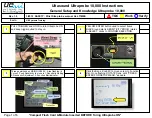
Concepts and Features
R&S
®
ZNC
35
User Manual 1173.9557.02 ─ 13
In most dialogs, however, it is possible to cancel an erroneous input before it takes effect.
The settings in such dialogs must be confirmed explicitly.
The two types of dialogs are easy to distinguish:
●
Dialogs with immediate settings provide a "Close" button but no "OK" button.
Example: "Trace Manager" dialog
●
Dialogs with confirmed settings provide both an "OK" button and a "Cancel" button.
Example: "Balanced Ports" dialog
Immediate settings can be undone using the UNDO key or "System > Undo".
3.2.4 Display Formats and Diagram Types
A display format defines how the set of (complex) measurement points is converted and
displayed in a diagram. The display formats in the "TRACE > FORMAT" menu use the
following basic diagram types:
●
Cartesian (rectangular) diagrams are used for all display formats involving a conver-
sion of the measurement data into a real (scalar) quantity, i.e. for "dB Mag",
"Phase", "Delay", "SWR", "Lin Mag", "Real", "Imag" and "Unwrapped Phase".
●
Polar diagrams are used for the display format "Polar" and show a complex quantity
as a vector in a single trace.
●
Smith charts are used for the display format "Smith". They show a complex quantity
like polar diagrams but with grid lines of constant real and imaginary part of the impe-
dance.
●
Inverted Smith charts are used for the display format "Inverted Smith". They show a
complex quantity like polar diagrams but with grid lines of constant real and imaginary
part of the admittance.
The analyzer allows arbitrary combinations of display formats and measured quantities
("TRACE > MEAS"). Nevertheless, in order to extract useful information from the data, it
is important to select a display format which is appropriate to the analysis of a particular
measured quantity; see
chapter 3.2.4.6, "Measured Quantities and Display Formats"
Screen Elements
















































